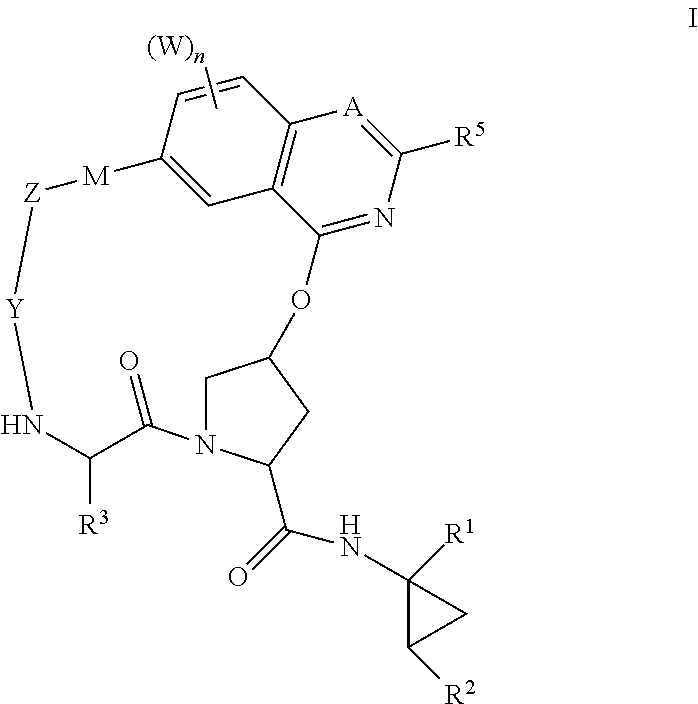HCV NS3 protease inhibitors
a protease inhibitor and hcv technology, applied in the direction of peptides, drug compositions, peptides, etc., can solve the problems of limited clinical benefit, no established vaccine for hcv, and treatment of hcv infection
- Summary
- Abstract
- Description
- Claims
- Application Information
AI Technical Summary
Problems solved by technology
Method used
Image
Examples
example 1
[0303](1R,2S)-1-({[(2R,4S,7S)-7-butyl-6,9-dioxo-3,4,6,7,8,9,12,13-octahydro-2H,11H-16,18-ethanediylidene-2,5-methanopyrido[2,3-k][1,10,3,6]dioxadiazacyclononadecin-4-yl]carbonyl}amino)-2-vinylcyclopropanecarboxylic acid (III-1)
[0304]
Step 1: Ethyl (4R)-4-[7-bromoisoquinolin-1-yl)oxy]-L-prolinate hydrochloride
[0305]
[0306]To a solution of trans 4-hydroxy L-BOC-proline (4.83 g, 20.9 mmol) in 100 mL DMSO at room temperature was added potassium t-butoxide (7.03 g, 62.66 mmol) in a single portion. The reaction mixture was stirred at r.t. for 30 min, cooled to 17° C. and 7-bromo-1-chloroisoquinoline (5.06 g, 20.9 mmol) added, the reaction allowed to warm to r.t. and stirred overnight. The reaction mixture was quenched with ice-cold 10% citric acid solution and partitioned with ethyl acetate. The organic layer was washed with aqueous citric acid solution, water and brine and the aqueous phases back extracted with ethyl acetate. The combined organic phases were dried over anhydrous sodium sul...
example 2
(1R,2S)-1-({[(2R,4S,7S)-7-Butyl-6,9-dioxo-3,4,6,7,8,9,12,13,14,15-decahydro-2H,11H-16,18-ethanediylidene-2,5-methanopyrido[2,3-k][1,10,3,6]dioxadiazacyclononadecin-4-yl]carbonyl}amino)-2-vinylcyclopropanecarboxylic acid (III-2)
[0314]
[0315]A solution of the olefin prepared as described in Example 1, Step 4 (180 mg, 0.353 mmol) in ethyl acetate (10 mL) was treated with 10% Pd / C and hydrogenated under a balloon of hydrogen for 18 h. The catalyst was removed by filtration and the filtrate was evaporated to give an oil. The oil was treated as described in Example 1, Step 5 to afford the title compound. LRMS (ESI) m / z 593 [(M+H)+; calcd for C32H40N4O7: 593].
example 3
(2R,4S,7S)-7-butyl-N-((1R,2S)-1-{[(cyclopropylsulfonyl)amino]carbonyl}-2-vinylcyclopropyl)-6,9-dioxo-3,4,6,7,8,9,12,13,15,16-decahydro-2H,11H-16,18-ethanediylidene-2,5-methanopyrido[2,3-k][1,10,3,6]dioxadiazacyclononadecine-4-carboxamide (III-3)
[0316]
[0317]The title compound was prepared as described for Example 2, by using (1R,2S)-1-amino-N-(cyclopropylsulfonyl)-2-vinylcyclopropanecarboxamide hydrochloride (Intermediate A1)(Wang et al WO 03 / 099274) in place of (1R,2S)-1-amino-2-vinylcyclopropanecarboxylic acid ethyl ester hydrochloride in the coupling step. LRMS (ESI) m / z 696 [(M+H)+; calcd for C35H45N5O8S: 696]. 1H NMR (500 MHz, CD3OD, ppm) δ 9.28 (s, 1 H), 7.97 (s, 1 H), 7.88 (d, J=5.9 Hz, 1 H), 7.72 (d, J=8.3 Hz, 1 H), 7.56 (dd, J=8.3 and 1.7 Hz, 1 H), 7.28 (d, J=5.9 Hz, 1 H), 6.13 (m, 1 H), 5.74 (m, 1 H), 5.27 (dd, J=17.1 and 1.2 Hz, 1 H), 5.10 (dd, J=10.3 and 1.5 Hz, 1 H), 4.65 (d, J=11.2 Hz, 1 H), 4.53 (m, 1 H), 4.44 (t, J=7.6 Hz, 1 H), 4.32 (m, 1 H), 3.99 (dd, J=11.7 and 3.2...
PUM
| Property | Measurement | Unit |
|---|---|---|
| temperature | aaaaa | aaaaa |
| pH | aaaaa | aaaaa |
| pH | aaaaa | aaaaa |
Abstract
Description
Claims
Application Information
 Login to view more
Login to view more - R&D Engineer
- R&D Manager
- IP Professional
- Industry Leading Data Capabilities
- Powerful AI technology
- Patent DNA Extraction
Browse by: Latest US Patents, China's latest patents, Technical Efficacy Thesaurus, Application Domain, Technology Topic.
© 2024 PatSnap. All rights reserved.Legal|Privacy policy|Modern Slavery Act Transparency Statement|Sitemap



